
Types of Affiliate Marketing Commission Rates
Here are some common types:
- Pay-per-sale (PPS): This is the most common type. You earn a percentage of the sale made through your affiliate link.
- Pay-per-click (PPC): In this model, you earn a fee based on the number of clicks your affiliate link receives, regardless of whether a sale is made.
- Pay-per-lead (PPL): You earn a commission when a user takes a specific action, like signing up for a newsletter or filling out a contact form.
These models cater to different goals, so it’s crucial to choose one that aligns with your marketing strategy.
Factors Influencing Commission Rates
Several factors can affect the commission rates offered by affiliate programs:
- Product Type: High-ticket items often offer higher commission rates. For example, expensive electronics may give affiliate marketers a larger cut than low-cost items like e-books.
- Industry Standards: Some industries have established norms. For instance, fashion and beauty products may generally offer commissions between 5% to 20%, while software subscriptions might provide 30% or more.
- Merchant Reputation: Well-established brands might offer lower commission rates due to their popularity, whereas newer brands may offer higher rates to attract affiliates.
Typical Affiliate Marketing Commission Rates in Affiliate Marketing
Knowing the average Affiliate Marketing Commission Rates across different industries can help you set realistic income goals. Here’s a brief overview:
Affiliate Commission Rates by Industry
| Industry | Commission Rate |
|---|---|
| Fashion & Beauty | 5% – 20% |
| Health & Wellness | 10% – 30% |
| Software & Technology | 20% – 50% |
| Finance | 30% – 60% |
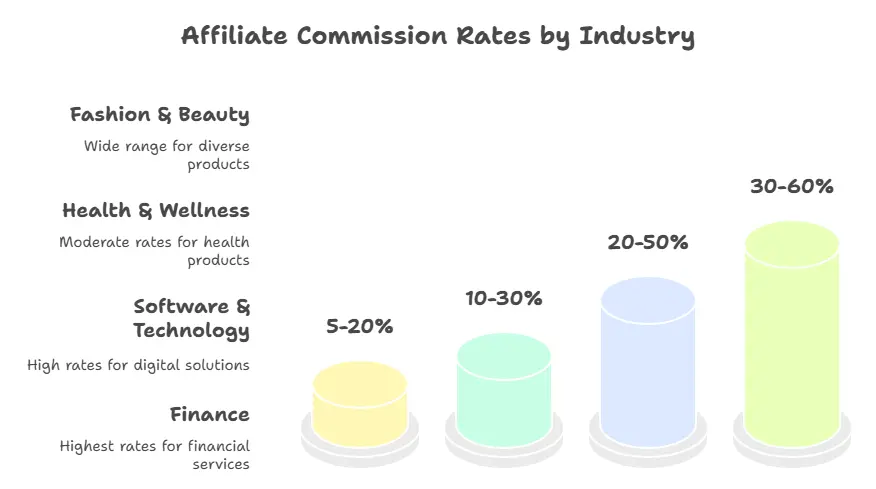
These figures can vary, but they serve as a useful guideline when assessing potential affiliate programs.
How to Choose the Right Affiliate Programs
When selecting affiliate programs, keep the following tips in mind:
- Research the Product: Choose products that resonate with your audience. Recommending something you believe in will likely yield better results.
- Check the Commission Structure: Ensure the commission structure aligns with your income expectations. Programs with a higher percentage might seem appealing, but check the product price to understand your profitability.
- Support and Resources: Some programs offer additional resources such as marketing materials that can facilitate your promotion efforts.
Some of the top performing affiliate networks to consider include Amazon Associates, ClickBank, and ShareASale.
How to Maximize Your Affiliate Earnings
To boost your affiliate marketing success, apply the following strategies:
- Leverage SEO: Optimize your content to rank better in search engines, driving more traffic to your affiliate links.
- Build an Email List: Use email marketing to directly promote your affiliate products, ensuring your audience receives tailored offers.
- Combine Content Types: Use blogs, videos, and social media posts to reach a wider audience and engage them in different forms.
Understanding Affiliate Marketing Commission Rates can be your ticket to financial success in the online world. Focus on quality partnerships, choose the right programs, and continually adapt your strategy for the best results.
Key Factors Influencing Commission Rates in Affiliate Marketing
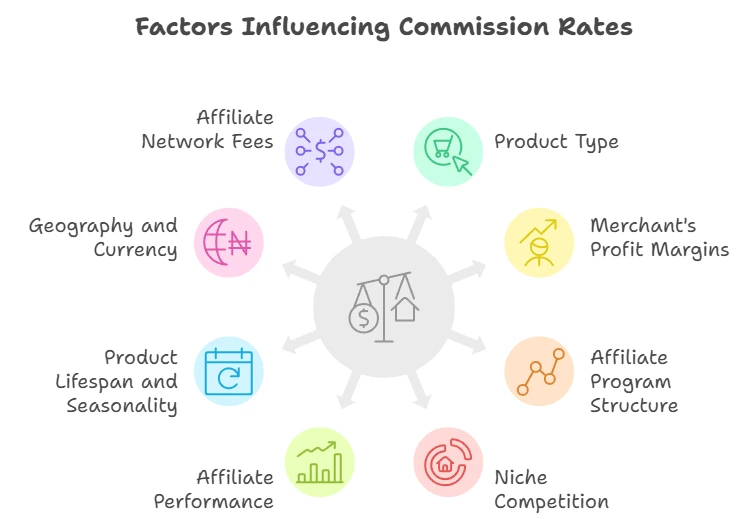
Understanding Affiliate Marketing Commission Rates is essential for both affiliates and merchants. The choices you make can significantly impact your earnings and success in this competitive field. Several key factors determine these rates, and being aware of them can help you make informed decisions.
1. Product Type
The type of product being sold plays a crucial role in setting commission rates. Generally, high-demand products tend to have higher margins, leading to more generous commissions for affiliates. For example, technology gadgets, luxury items, and subscription services often offer higher commissions than low-cost, everyday items. The average Affiliate Marketing Commission Rates can be categorized as follows:
Average Commission Rates by Product Type
| Product Type | Average Commission Rate |
|---|---|
| Digital Products (eBooks, Courses) | 30% – 50% |
| Physical Goods (Electronics, Clothing) | 5% – 20% |
| Subscription Services | 10% – 50% |
2. Merchant’s Profit Margins
Commission rates are heavily influenced by a merchant’s profit margins. Businesses with higher profit margins can afford to offer more attractive commissions. For instance, a merchant selling software with high profit margins can grant affiliates a better rate than a retail store selling discounted products. Consider researching the typical profit margins in your niche to grasp what to expect.
3. Affiliate Program Structure
Affiliate programs can vary widely in their structure. For example, some programs are pay-per-sale (PPS), while others might operate on a pay-per-click (PPC) basis. Each structure has its implications for Affiliate Marketing Commission Rates:
- Pay-Per-Sale (PPS): Affiliates earn a commission only when a sale is completed, typically resulting in higher commission potential.
- Pay-Per-Click (PPC): Affiliates get paid for clicks, regardless if a sale is made, generally offering lower rates.
- Pay-Per-Lead (PPL): This model compensates affiliates for generating leads, often leading to moderate rates.
4. Niche Competition
The level of competition within a niche can greatly affect Affiliate Marketing Commission Rates. In heavily saturated markets, merchants may lower commission rates to remain competitive. Conversely, in less competitive niches, higher rates can attract affiliates. Take time to assess how the competition impacts your potential earnings.
5. Affiliate Performance
Your performance as an affiliate can directly influence your commission rates. Many merchants offer tiered commission structures, where top-performing affiliates receive higher rates. Maintaining high conversion rates can help you unlock these better commissions. Some programs incentivize affiliates with bonuses for reaching sales milestones, which can significantly boost your income.
6. Product Lifespan and Seasonality
Some products may have a short lifespan or only be relevant during certain seasons. For example, holiday decorations have high sales during the season but may offer lower commissions otherwise. Understanding product cycles can guide you in selecting the best affiliate programs to maximize commissions throughout the year.
7. Geography and Currency
Your target audience’s location can influence Affiliate Marketing Commission Rates. Some regions have higher purchasing power, enabling merchants to offer better rates to affiliates. Also, merchants may adjust their commissions based on currency stability and exchange rates, which can affect earnings for international affiliates.
8. Affiliate Network Fees
Many merchants work with affiliate networks to manage their programs. These networks often charge fees, which can affect the commission rates affiliates receive. For example, if a network takes a cut of the commission, the affiliate’s payout may be lower. It’s helpful to weigh the value of network services against their fees when considering collaboration.
Understanding Affiliate Marketing Commission Rates is vital for building a successful affiliate strategy. By considering product types, merchant profit margins, program structures, market competition, and geographical factors, you can optimize your earning potential. Assess these elements carefully and choose affiliate partners that align with your goals. For more insights, check out ShareASale or visit Awin for the latest information on affiliate programs and commission strategies.
Comparing Different Types of Affiliate Programs and Their Payout Structures
When venturing into the world of affiliate marketing, understanding the various types of affiliate programs and their payout structures is essential. Different programs offer unique Affiliate Marketing Commission Rates and payment models, which can dramatically affect your earnings. By comparing these structures, you can choose the one that aligns with your goals and niche.
Types of Affiliate Programs
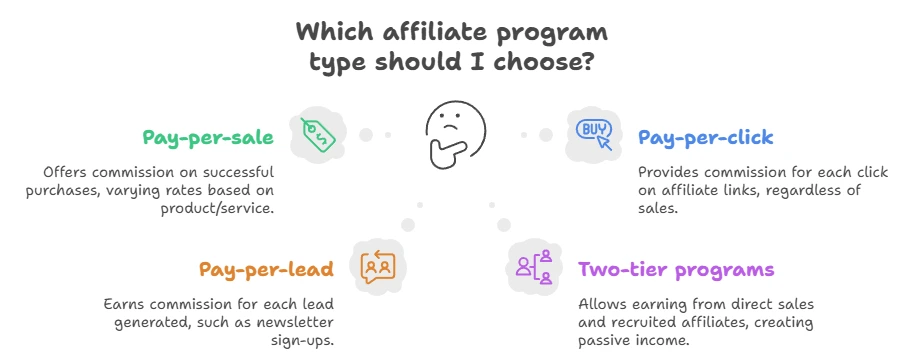
Affiliate programs can be categorized into several types, each with its own strengths and unique commission rates. The primary types include:
- Pay-per-sale (PPS): In this model, affiliates earn a commission when a referred customer makes a purchase. The commission rate can vary widely based on the product or service.
- Pay-per-click (PPC): Affiliates earn a fee based on the number of clicks they generate on an affiliate link, regardless of whether a sale occurs.
- Pay-per-lead (PPL): Here, affiliates earn a commission when a referred customer submits some form of lead information, like signing up for a newsletter or filling out a contact form.
- Two-tier programs: These allow affiliates to earn commissions not just from their direct sales but also from commissions earned by other affiliates they recruit. This can create a passive income stream.
Comparison of Payout Structures
Below is a comparison of the different payout structures associated with these affiliate programs. This table provides a concise view of Affiliate Marketing Commission Rates and their potential impact on your income.
Affiliate Program Types and Typical Commission Rates
| Affiliate Program Type | Typical Commission Rate | Best For |
|---|---|---|
| Pay-per-sale (PPS) | 5% – 50% | Retail and e-commerce |
| Pay-per-click (PPC) | $0.01 – $0.50 per click | Traffic generation and web advertising |
| Pay-per-lead (PPL) | $1 – $100 per lead | Services like insurance or finance |
| Two-tier programs | Variable, plus commissions from 2nd tier | Building a network of affiliates |
Evaluating Commission Structures
When evaluating affiliate programs, focus on the commission structure and how it applies to your audience. While higher Affiliate Marketing Commission Rates might seem appealing, consider the following:
- Product Fit: Ensure the product aligns with your audience’s interests. A high commission might not mean much if your audience doesn’t want the product.
- Conversion Rates: Programs that offer lower commissions but have high conversion rates can be more profitable than programs with higher commissions and low conversions.
- Reputation of the Company: Partnering with reputable brands can lead to higher trust levels, potentially increasing conversion rates.
Understanding Your Goals
Your goals will influence which affiliate program is best for you. Are you looking for a quick payout, or are you willing to invest in long-term revenue streams? For instance:
- If you want to earn quickly, ClickBank, known for its high PPS rates, might be ideal.
- If building a network interests you, consider joining a two-tier program like AvantLink.
- For leads, services like Fiverr may offer lucrative PPL commissions.
Final Thoughts on Affiliate Marketing Commission Rates
Choosing the right affiliate program involves understanding both the types of programs available and their respective payout structures. By carefully evaluating Affiliate Marketing Commission Rates, understanding your audience, and aligning your objectives with the right program, you can maximize your potential earnings in affiliate marketing. The key is to select a program that not only offers solid Affiliate Marketing Commission Rates but also resonates with your brand and audience.
Tips for Maximizing Earnings with High-Commission Affiliates
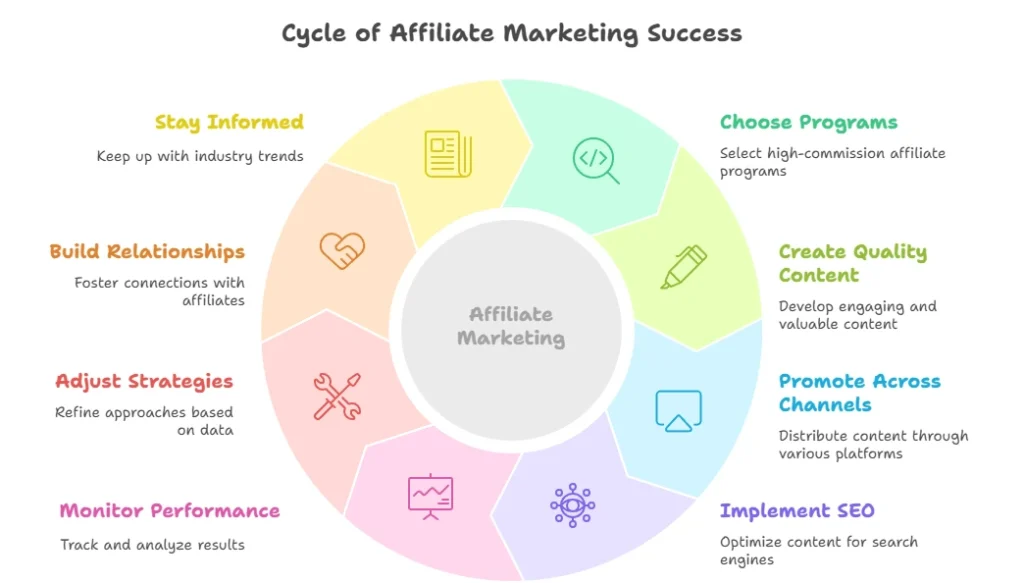
When diving into affiliate marketing, one of your main goals will be to maximize your earnings. One powerful strategy for achieving this is partnering with high-commission affiliates. These programs offer greater payouts, but it’s essential to manage your approach effectively to leverage their full potential. Here’s how to do just that.
Choose the Right High-Commission Programs
The first step in maximizing earnings with high-commission affiliates is to carefully select your programs. Look for affiliate programs that align closely with your niche and target audience. Programs offering commissions between 20-50% or more are ideal. Popular high-commission networks include:
Make sure to read the terms and conditions of each program. Some programs may have specific rules about how you can promote their products.
Focus on Quality Content
High-quality content is the backbone of successful affiliate marketing. When you create valuable, engaging content, it helps build trust with your audience. This trust leads to higher conversion rates. Here are some content strategies:
- Product Reviews: Write in-depth reviews of high-commission products. Share your personal experiences and provide honest opinions.
- How-To Guides: Create guides that show your audience how to use the products you promote. This adds value and encourages them to make a purchase.
- Comparisons: Compare similar products side-by-side, highlighting the benefits of the one you recommend.
Utilize Multiple Channels for Promotion
To reach a broader audience, use various channels for promoting your affiliate links. Don’t limit yourself to just one or two platforms. Here are some effective channels to consider:
- Social Media: Platforms like Instagram, Facebook, and Pinterest can be great for showcasing products and directing traffic to your affiliate links.
- Email Marketing: Build an email list and send newsletters featuring the products you promote. Personalized recommendations can lead to more sales.
- Blogging: Maintain a blog dedicated to topics in your niche and integrate affiliate links naturally within your posts.
Leverage SEO Strategies
Search engine optimization (SEO) can significantly increase your visibility online. Here are some key SEO strategies to boost your affiliate earnings:
- Keyword Research: Utilize tools like Google Keyword Planner to find high-traffic keywords relevant to your products.
- Optimized Content: Ensure your content includes these keywords, particularly in headings and first paragraphs, while maintaining a natural flow.
- Backlink Building: Aim to gain backlinks from reputable sites. This can positively impact your search rankings, driving more traffic to your affiliate products.
Monitor and Adjust Your Strategies
Keep an eye on your affiliate marketing performance by using tracking tools. Understand which products are performing well and which ones aren’t. Tools like Google Analytics can help you analyze traffic sources and user behavior. Here’s what to monitor:
- Click-Through Rates: Assess how many users click your affiliate links.
- Conversion Rates: Track the percentage of clicks that result in purchases.
- Return on Investment (ROI): Calculate how much you earn versus how much you spend on promotions.
Build Relationships with Affiliates
Building strong relationships with affiliate managers can open doors to exclusive offers, higher commission rates, or better inventory access. Communication is key. Regularly reach out with questions or concerns, and keep them updated on your performance. This effort can lead to enhanced partnerships.
Stay Informed on Industry Trends
Affiliate marketing is constantly evolving. Stay updated on trends, new programs, and effective marketing techniques. Follow blogs and news sites in the affiliate marketing niche, such as Affiliate Buzz or Affilorama to gain insights that can help you refine your strategies.
Maximizing your earnings with high-commission affiliates requires a thoughtful approach, quality content, and robust strategies. By choosing the right programs and employing effective marketing techniques, you can optimize your affiliate earnings and build a sustainable income stream.
The Future of Affiliate Marketing Commission Rates: Trends to Watch
As the digital landscape evolves, so too does the structure of Affiliate Marketing Commission Rates. Understanding the trends in this sector is essential for both marketers and businesses looking to optimize their earning potential. Here are key trends that are shaping the future of Affiliate Marketing Commission Rates.
Performance-Based Models are Gaining Traction
In recent years, companies are increasingly adopting performance-based commission models. These models, which reward affiliates based on their results rather than a flat rate, encourage affiliates to drive higher quality traffic. You can expect to see Affiliate Marketing Commission Rates that fluctuate based on metrics such as:
- Conversion Rate
- Customer Engagement
- Sales Volume
This movement towards performance-based compensation aligns the interests of both affiliates and merchants, leading to more sustainable partnership growth.
Growing Emphasis on Subscription-based Businesses
More businesses are shifting towards subscription models, which can significantly alter the commission landscape. Affiliates now have opportunities to earn recurring commissions, making it appealing for them to promote these types of products. Typically, businesses offer higher Affiliate Marketing Commission Rates for subscription services, potentially ranging from 20% to 50% of the customer’s monthly fee.
Increased Use of Technology and Analytics
With advances in technology, businesses can track affiliate performance more accurately than ever before. This capability allows companies to tailor Affiliate Marketing Commission Rates based on real-time data. Different metrics can be analyzed, including:
- Click-Through Rates
- Customer Retention Rates
- Average Order Value
By leveraging these analytics, businesses can optimize their commission structures to reward high-performing affiliates significantly. It’s essential for you as an affiliate to stay updated on tools like Affise that help manage and optimize your campaigns.
Tiered Commission Structures Become Popular
Many companies are moving toward tiered commission structures, where affiliates can earn higher rates as they hit specific sales milestones. For example, a brand might start with a 10% commission and increase it to 20% after an affiliate generates 50 sales. This strategy incentivizes affiliates to push harder and ensures greater loyalty to a brand. Such structures can create a more collaborative environment between brands and their affiliates.
Focus on Influencer Partnerships
As social media continues to dominate marketing channels, influencer partnerships are becoming increasingly essential. Affiliate Marketing Commission Rates through influencers can vary considerably, often based on an influencer’s reach and engagement. Some influencers might command commissions in the range of 10% to 30%, but the key will be the quality of engagement they provide rather than just sheer numbers. Brands are focusing more on how well the influencer can connect with their audience rather than just their follower count.
Global Markets and Diversifying Commission Rates
Expanding into international markets allows affiliate companies to diversify their commission structures. Regions often have different consumer behaviors, leading to unique Affiliate Marketing Commission Rates tailored for specific demographics. For example, while U.S. affiliates may encounter commission rates of 5% to 50%, those in Asia or Europe might see rates fluctuating based on cultural and economic contexts.
Affiliate Commission Rates by Region
| Region | Typical Commission Rate |
|---|---|
| North America | 5% – 50% |
| Europe | 5% – 40% |
| Asia | 10% – 30% |
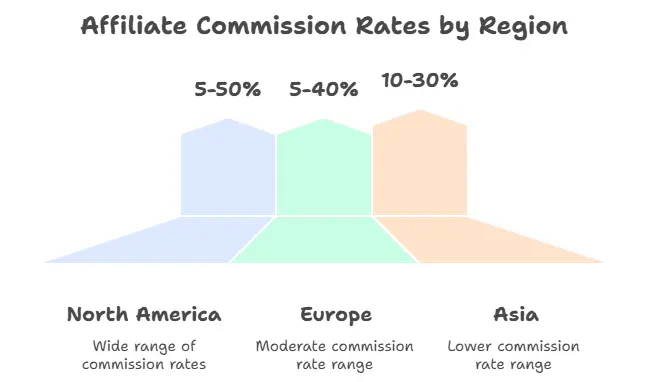
As more markets become interconnected, the industry overall will likely benefit from adaptable commission rates that cater to local preferences. For more insights into global affiliate marketing trends, explore Affiliate Marketing.
Ultimately, the future of Affiliate Marketing Commission Rates seems bright and dynamic. Keeping yourself informed about trends and adjusting your strategies based on these insights can provide you with an edge in the competitive landscape of affiliate marketing. Stay connected with industry resources like Impact to continually refine your approach as these trends unfold.
Conclusion
Navigating the world of Affiliate Marketing Commission Rates can be both exciting and daunting. By understanding the basics, like how commission rates are structured and the factors that influence them, you position yourself for greater success. Each type of affiliate program offers unique benefits, which means that a tailored approach is essential. Think about which payout structure aligns best with your goals and audience.
Maximizing your earnings requires more than just signing up for high-commission programs. It involves strategic planning, quality content creation, and building genuine relationships with your audience. By focusing on these key aspects, you can enhance your effectiveness and attract higher payouts over time.
As we look ahead, it’s important to keep an eye on the trends shaping the future of Affiliate Marketing Commission Rates. Innovations in technology, shifts in consumer behavior, and evolving market demands are all factors that could influence how commissions are determined. Staying informed and adaptable will ensure you remain competitive in this dynamic landscape.
By applying the insights shared throughout this article, you can enhance your affiliate marketing efforts and ultimately boost your income. Whether you’re just starting out or looking to refine your existing strategies, understanding Affiliate Marketing Commission Rates and leveraging them smartly can lead to significant growth. Keep exploring, testing, and evolving your approach as the affiliate marketing world continues to evolve. Your success is just around the corner!